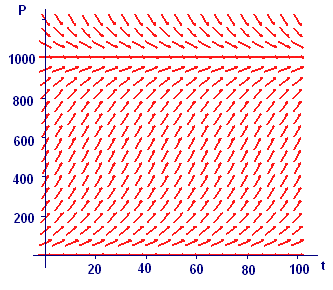Chapter 6
Antidifferentiation
6.3 The Logistic Growth Equation
Exercises
- Sketch by hand the solution of each of the following initial value problems.
You do not need to solve the problems
— just show the essential features of the solutions.
- `(dP)/(dt)=2Ptext[(]4-Ptext[)], Ptext[(]0text[)]=1`
- `(dP)/(dt)=2Ptext[(]4-Ptext[)], Ptext[(]0text[)]=4`
- `(dP)/(dt)=2Ptext[(]4-Ptext[)], Ptext[(]0text[)]=3`
- `(dP)/(dt)=2Ptext[(]4-Ptext[)], Ptext[(]0text[)]=5`
- For each of the following relations, find numbers `A` and `B` so that the relation holds for all appropriate values of `x`.
- `A/x+B/(5-x)=1/(xtext[(]5-xtext[)])`
- `A/x+B/(x+4)=1/(3xtext[(]x+4text[)])`
- `A/x+B/(5+x)=1/(xtext[(]5+xtext[)])`
- `A/x+B/(x-4)=1/(3xtext[(]4-xtext[)])`
- `A/(2+x)+B/(2-x)=1/(4-x^2)`
- `A/(3-2x)+B/(3+2x)=1/(9-4x^2)`
- Find an antiderivative for each of the following functions.
- `1/(xtext[(]5-xtext[)])` for `0<x<5`
- `1/(3xtext[(]x+4text[)])` for `x>0`
- `1/(xtext[(]5+xtext[)])` for `x>0`
- `1/(3xtext[(]4-xtext[)])` for `0<x<4`
- `1/(4-x^2)` for `-2<x<2`
- `1/(9-4x^2)` for `-3/2<x<3/2`
- In Activity 3 you showed that
an antidifferential of `(dx)/(xtext[(]c-xtext[)])=1/c ln x-1/c lntext[(]c-xtext[)]`
when `x` is restricted to range between `0` and `c`. Show that the restriction on the range of `x` can be dropped — that is, we can allow `x` to be negative or greater than `c` — if we write the formula asan antidifferential of `(dx)/(xtext[(]c-xtext[)])=1/c ln |x|-1/c ln|c-x|`.
- Use the preceding exercise to show that
- `ln (x/(x-1))` is an antiderivative for `1/(xtext[(]1-xtext[)])` for `x>1`.
- `ln ((-x)/(x-1))` is an antiderivative for `1/(xtext[(]1-xtext[)])` for `x<0`.
- Find an antiderivative for each of the following functions for the indicated domain.
- `1/(xtext[(]5-xtext[)])` for `x<0`
- `1/(3xtext[(]x+4text[)])` for `-4<x<0`
- `1/(xtext[(]5+xtext[)])` for `-5<x<0`
- `1/(3xtext[(]4-xtext[)])` for `0<x<4`
- `1/(4-x^2)` for `x>2`
- `1/(9-4x^2)` for `x<-3//2`
- Find an antiderivative for each of the following functions for the indicated domain.
- `1/(xtext[(]5-xtext[)])` for `x>5`
- `1/(3xtext[(]x+4text[)])` for `x<-4`
- `1/(xtext[(]5+xtext[)])` for `x<-5`
- `1/(3xtext[(]4-xtext[)])` for `0<x<4`
- `1/(4-x^2)` for `x<-2`
- `1/(9-4x^2)` for `x>3//2`
- In case you didn't do Exercise 9 in Section 4.5 (or don't remember how it went), we repeat a version of it here for your convenience. We start with the logistic growth equation,
`(dP)/(dt)=kPtext[(]M-P text[)]`,
where `Ptext[(]t text[)]` is the population at time `t`, `M` is the maximum supportable population of the environment, and `k` is a proportionality constant.- Explain why the population must be growing most rapidly at a time at which the second derivative of `P` is zero.
- Differentiate both sides of the differential equation to find an expression for the second derivative. (The Product Rule works for differentiating the right-hand side, but you can make the computation easier if you rewrite the expression in another form first.) Be careful with your differentiation — you are differentiating with respect to `t`, not `P`, so the Chain Rule must come into play every time you run into the unknown function `P`.
- What does your expression for the second derivative tell you about the population size when the growth rate is maximal?
- How does this lead to our estimate for `M` in the U.S. Population Example?
- Figure E2 (repeated here from Section 6.2) makes it clear that the logistic growth model is biologically meaningful even if `P_0` is greater than `M`. This might be the case if there were a sudden wave of immigration — for example, large numbers of refugees from a civil war in a neighboring country — or an overstocking of a wildlife refuge, or a concentration of wildlife in a habitat that is shrinking because of development. Find the general solution of the logistic growth model when `P_0` is greater than `M`. (Hint: Review Exercise 4.)
 Figure E2 Slope field for `(dP)/(dt)=0.00009P text[(]1000-P text[)]`
Figure E2 Slope field for `(dP)/(dt)=0.00009P text[(]1000-P text[)]` - The logistic initial value problem,
`(dP)/(dt)=kPtext[(]M-P text[)], Ptext[(]0text[)]=P_0,`
is mathematically meaningful for every starting point — negative, zero, less than `M`, equal to `M`, and greater than `M`. Expand on the preceding exercise to find the general solution in every case. - You may have noticed that we never checked our solution of the logistic growth equation. We leave this to you, with the warning that this is a serious challenge to your algebraic skills. You will find it easiest to work with the form
`P=(P_0 M)/(text[(]M-P text[)]e^(-Mkt)+P_0`.
First do the easy part: Check that `P=P_0` when `t=0`. Then verify that the function `Ptext[(]t text[)]` satisfies the growth equation`(dP)/(dt)=kPtext[(]M-P text[)]`.
[Hint: Calculate `dP`/`dt` and `kPtext[(]M-P text[)]` separately. Then simplify each until you can see that the two expressions are the same.]

